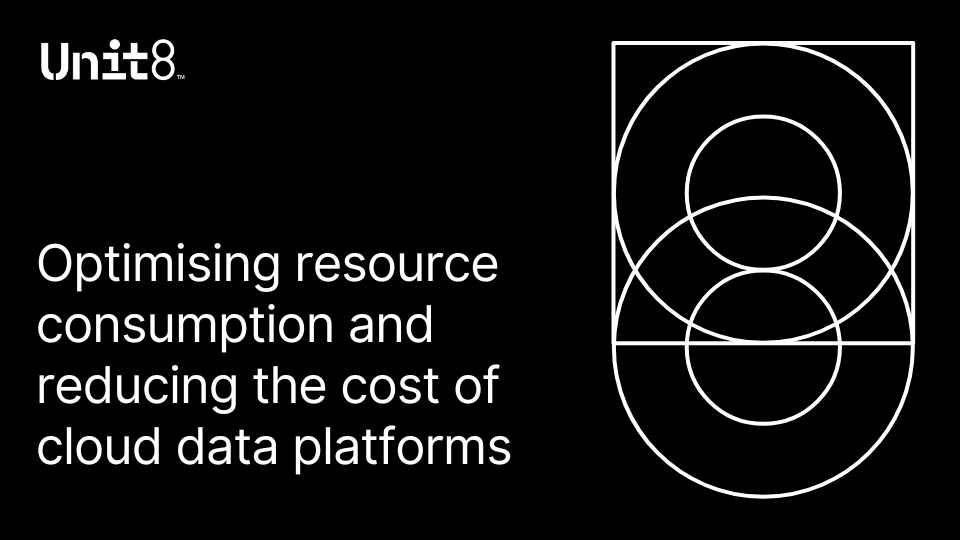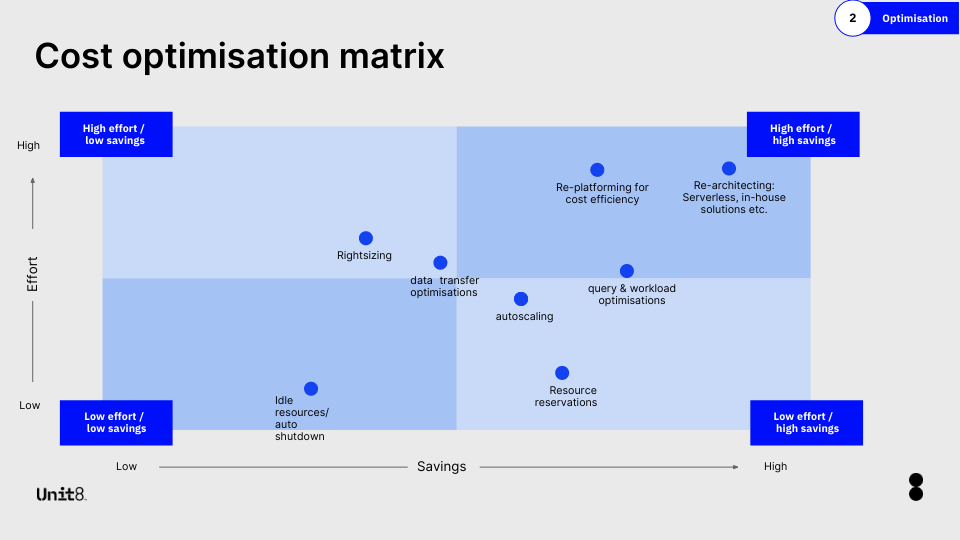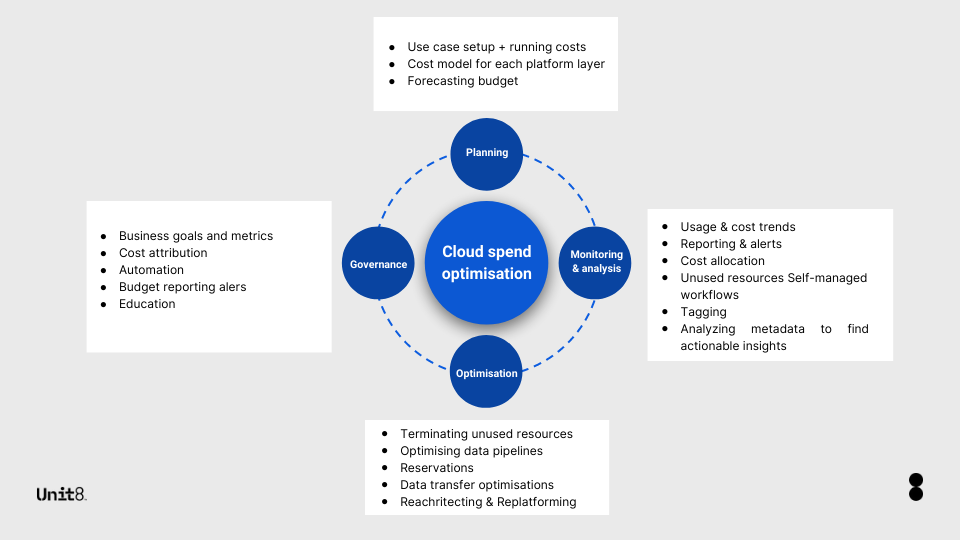
- Jul 20, 2023
- 10 minutes
-
 Tomasz Chudzik
Tomasz Chudzik
The Rising Cost of Cloud Adoption
Cloud adoption is fast becoming the norm among enterprises, with most companies spending a significant portion of their IT budgets on cloud platforms. In fact, studies show that the cost of running data platforms ranges from $6 to $15 million for medium enterprises and $17 to $42+ million for larger enterprises. Despite this, up to 30-40% of the resources and money deployed to the cloud are wasted, resulting in unnecessary overspending.
To control cloud costs, companies need to prioritize a combination of monitoring, analysis, governance, and culture. One way to achieve this is by planning data platforms with cost in mind while keeping business goals at the forefront. Cost cannot be the only priority, and it is advisable to use KPIs such as actual spend versus forecasts to track progress.
Common Causes of Cloud Overspend
Cloud overspending can occur for several reasons, chief of which are idle and underused resources, over-provisioned resources, lack of necessary skills, and use of different technologies. To optimize cloud resources better, companies need to be proactive by analyzing metric logs, collecting data from different parts of the platform, and identifying performance bottlenecks.
-
Idle and Underused Resources
One of the most common causes of cloud overspend is idle and underused resources. When a company deploys cloud resources for a specific task or workload, sometimes those resources are left idle or underused after the task is completed, and the costs of those resources are still being incurred. Idle resources such as virtual machines, storage space, and load balancers can accumulate over time, leading to increased costs that affect the overall cloud infrastructure budget.
-
Over-provisioned Resources
Another cause of cloud overspend is over-provisioned resources. This occurs when a company allocates more resources than necessary to handle a specific task or workload. Over-provisioned resources may include virtual machines, storage, or database instances. While over-provisioning may seem like a good idea in the short term, it can lead to unnecessary costs and slow down the overall infrastructure system. To avoid over-provisioning, companies should monitor resource usage and adjust allocations accordingly.
-
Lack of Necessary Skills
A lack of the necessary skills to manage cloud infrastructure can also lead to overspending. Cloud infrastructure management requires a specific set of skills that include cloud computing, data analysis, and cost optimization. It is essential to invest in the necessary skills or hire professionals or consultants to manage cloud infrastructure effectively.
Also, a lack of necessary skills of teams that design and build cloud solutions is a key factor. Often such teams apply architecture principles from the on-prem world, ignoring concepts like auto-scaling, specialised managed services etc. This also leads to higher infrastructure and maintenance costs
-
Lack of cloud strategy
Different technologies in cloud infrastructure can also lead to overspending. For example, if a company uses multiple cloud providers, it may be challenging to manage the costs associated with each provider. Different cloud providers also offer different pricing plans, making it difficult to compare and manage the costs effectively. Additionally, different cloud technologies may require different skills to manage, which can lead to overspending if skills are lacking. To address this challenge, companies may consider deploying a multi-cloud strategy, but this should be approached with caution and proper governance in place.
Proactive Steps towards Cloud Optimization
Cloud adoption has become a common trend among companies, and it is a crucial aspect of modern business. However, due to the high cost of running data platforms it is important to take proactive steps towards cloud optimization. In this part, we will discuss some of the ways to take proactive steps towards cloud optimization.

One of the ways to optimize cloud usage is to analyze metrics logs and collect data from different parts of the platform. The key is to identify performance bottlenecks and ensure that only necessary resources are used. This is important because cloud overspend can occur in idle and underused or over-provisioned resources. By analyzing metrics logs and collecting data, it is possible to identify these inefficiencies and take corrective action.
Cost allocation is also an important aspect. It involves breaking down the overall cost of running the cloud platform into smaller units and identifying the cost drivers of each unit. Using this method, it is possible to track the actual cost of running the platform versus the forecast cost and take corrective action where necessary. Cost allocation allows you to attribute cost to a single solution/use-case running on the platform. This allows you to compare the value generated by the use-case with the cost of running it. It is also recommended to set cost policies and limits to prevent the overuse of cloud resources.
Educating users on the cost implications of running different workloads is another key point. It is important to build a culture of optimization, where employees are encouraged to only use the resources they need and optimize their code for their workloads. By doing so, the company can reduce the overall cost of running the platform, while still achieving the desired business goals.
For larger operations, it is recommended to build or adopt one of the existing custom tools to extract actionable cost-reducing insights. These tools can be used to identify inefficiencies and eliminate waste. For smaller deployments, it is recommended to use off-the-shelf tools or what the chosen cloud provider offers.
Deploying a multi-cloud strategy to reduce the overall cost should be approached with caution because maintaining a multi-cloud strategy can be expensive. Good governance is critical to making consumers responsible, using policies and incentives to drive costs down, and encouraging user collaboration.
Best Practices for Cloud Governance and Education
Cloud optimization is not just about monitoring and analysis but also requires proper governance and education. It is important to educate users on the cost implications of running different workloads to ensure that they understand the impact of their actions on the overall cost.
1. Governance
Governance is the process of making consumers responsible for their cloud usage by defining policies that drive cost down and encourage collaboration among users. It involves setting cost policies and limits, enforcing compliance, and monitoring usage. Here are some best practices for cloud governance:
- Assign responsibility for cloud governance to a dedicated team or individual
- Define clear policies for cost allocation, usage limits, and compliance
- Track usage and costs at a granular level to identify overspending and cost inefficiencies
- Use automation and machine learning to enforce governance policies and optimize resource allocation
- Provide incentives for user compliance, such as credits for users who adhere to policies
2. Education
Educating users on cloud usage and cost management is essential to reduce cloud overspend. Without proper education, users may not be aware of the cost implications of their actions, leading to overspending and inefficiencies. Here are some best practices for that:
- Provide training to users on cloud usage best practices and optimising cloud cost
- Establish a culture of cost awareness, where users are encouraged to think about the cost impact of their actions
- Communicate the cost impact of each workload to users, enabling them to make informed decisions about their cloud usage
- Provide dashboards and reports that enable users to monitor their cloud usage and costs
- Incentivize users to optimise their cloud usage and reduce costs, such as rewards for reducing usage or cost
3. Cloud Optimization Tools
Cloud optimisation tools are essential for identifying cost inefficiencies and optimising cloud usage. Here are some best practices for cloud optimisation tools:
- Select the best tool for the task at hand, considering the deployment’s complexity and scale.
- Use automation and machine learning to optimise cloud usage, such as scaling resources up and down automatically based on demand.
- Employ custom tools to extract actionable cost-reducing insights for more extensive operations.
- Invest in off-the-shelf tools or use the ones the cloud provider provides for smaller deployments.
- Regularly review tools to ensure they are still the best fit for the deployment.
Conclusion

In conclusion, cloud optimisation is not just about monitoring and analysis but also involves proper governance and education. By implementing best practices, you can reduce cloud overspend and optimise cloud usage. The critical drivers towards cost optimisation are granular cost and resource tracking, cost allocation, setting cost policies and limits, and educating users on the cost implications of running different workloads. Follow the tips and keep your cloud deployment optimised for cost reduction.



